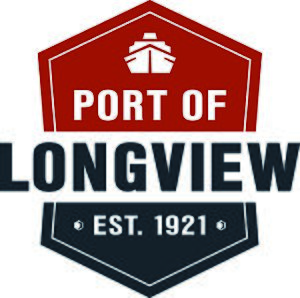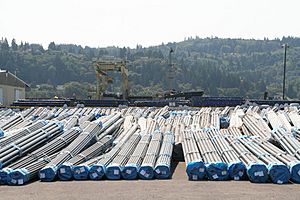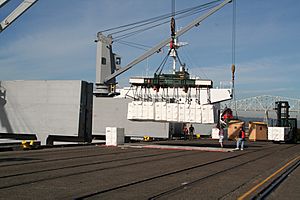Port of Longview facts for kids
The Port of Longview is a large port authority located in Longview, Washington. It sits on the Columbia River in the southwest part of Washington, United States. This port is a "deep-water" port, meaning it's deep enough for very large ships to dock.
The Port of Longview was started in 1921 by a state law in Washington. It works like a local government agency. Three people called commissioners manage the port. Local people vote for these commissioners, and they serve for six years. They are in charge of how the port operates.
The Port runs a big area where ships and barges from all over the world come and go. Workers load and unload different kinds of goods. These workers are part of a labor union and use huge machines. They operate cranes, forklifts, and other special equipment.
The Port is well-connected to other places. Ships can use the Columbia River to reach the Pacific Ocean. Trains can use the BNSF Railway and Union Pacific tracks. Trucks can use Interstate 5, a major highway that runs from Mexico to Canada.
The Port also rents out land for businesses. It helps fund fun projects in Cowlitz County too.
Contents
What the Port Does
The main goal of the Port of Longview is to help businesses grow. It does this by making smart public investments. This helps the local communities and economy.
Where is the Port?
The Port of Longview is about 66 miles inland from the Pacific Ocean. It's on the deep Columbia River shipping channel. If you drive, it's about 120 miles from Seattle, Washington and 40 miles from Portland, Oregon. The Port's area covers the northern two-thirds of Cowlitz County. This goes from just north of Kalama, Washington up to the Lewis County line.
How Goods Get Around
Train Connections
The main train lines, BNSF Railway and Union Pacific, are about five miles from the Port. The Longview Switching Company connects these main lines to the Port. Then, the Port's own locomotives move trains and rail cars to the docks and other areas.
Highway Access
The Port is only about three miles from Interstate 5. This is a major highway that stretches all the way from Mexico to Canada. This makes it easy for trucks to move goods to and from the Port.
Port Facilities
The Port has eight marine terminals, which are like big docks. It also has covered and uncovered warehouses. There are open storage areas too. These places are used to temporarily hold cargo before it's loaded onto trucks, special trailers, or trains.
Here are some of the main terminals:
- Bridgeview Terminal (Berth 1 & 2) – Used for exporting farm products, chemicals, and minerals.
- Berth 4 – A dock for loading bulk goods, currently available for new projects.
- Berth 5 – Exports petroleum coke and is run by the Port for BP.
- Berth 6 – Handles general cargo like steel, parts for wind energy, and forest products.
- Berth 7 – Used for general cargo, loading barges, and importing bulk goods.
- Berth 8 – A versatile dock for general cargo, special projects, forest products, and steel.
- Berth 9 – A large facility for exporting bulk goods, called the Export Grain Terminal.
Types of Cargo
The Port handles many different types of goods:
- Dry Bulk: These are loose materials like petroleum coke, potash, soda ash, soya meal, talc, and bentonite clay.
- Break Bulk: These are goods that are shipped in individual pieces, like steel and logs.
- Project Cargo: These are very large or heavy items. Examples include parts for wind turbines (like towers, blades, and engine parts), huge electrical generators, and other oversized parts for factories.
Port History
In 1911, Washington state passed laws allowing communities to create port districts. They could also elect commissioners to manage these ports. The Port of Longview was officially started in 1921. This happened after people living in the area voted for it. The port was first called the Port of Kelso. But a state law said ports had to be named after the biggest city in their district. So, people voted again to change the name to the Port of Longview.
When it first started, the Port mainly exported forest products like logs and lumber to Asia. However, these exports started to decrease in the 1980s. Today, the Port no longer handles logs. Instead, it now handles steel, bulk goods, and large project cargo.
Images for kids










